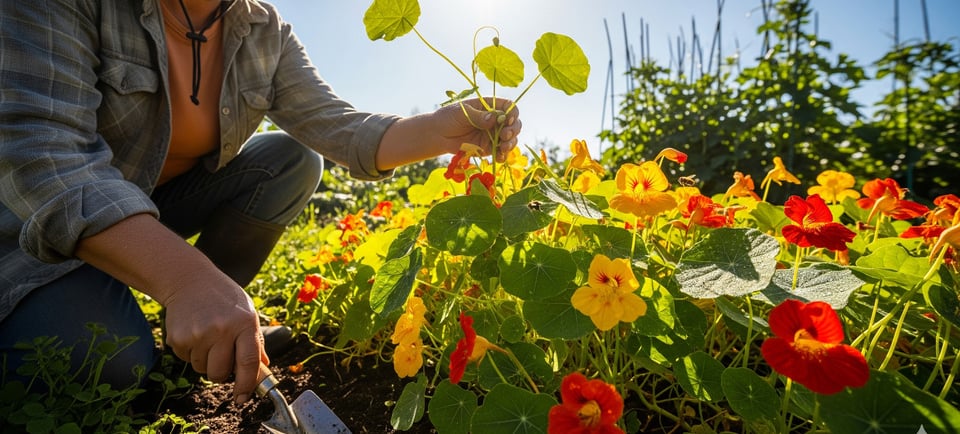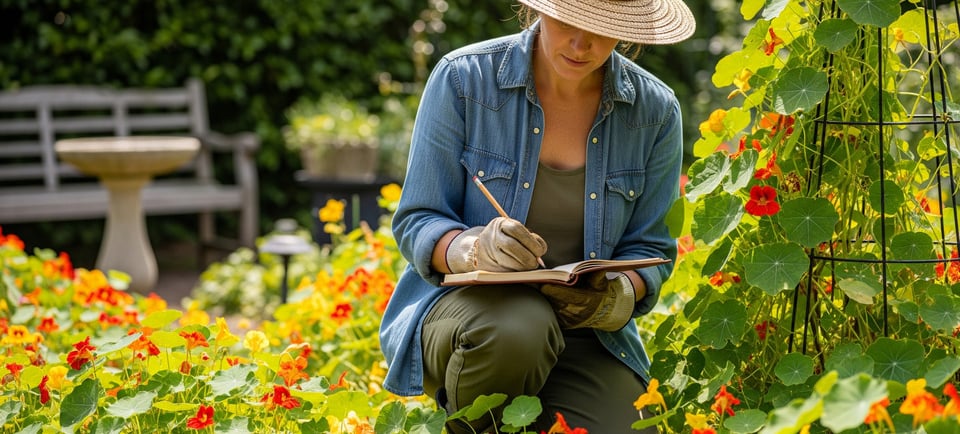Growing Nasturtiums to Give Back to Your Garden (and Kitchen!)
Nasturtiums are a truly versatile plant, serving as an effortless garden hero, a peppery culinary ingredient, and a natural pest deterrent all at once. This forgiving plant thrives on neglect and actually prefers poor soil, producing a profusion of cheerful blooms instead of just lush foliage. With their easy-to-handle seeds, they are also a perfect choice for introducing children to the joys of gardening
9/8/20255 min read


You know that feeling when you discover something truly versatile, something that just keeps on giving? That’s exactly how I feel about nasturtiums. You see them everywhere, their cheerful, trumpet-like blossoms in vibrant shades of orange, red, and yellow spilling over fences and out of containers. Maybe you've even admired them in a friend's garden or spotted them as a whimsical garnish on a salad at a restaurant. But honestly, this seemingly simple plant is so much more than just a pretty face. It’s a garden workhorse, a culinary surprise, and a pest-control secret weapon, all rolled into one. It’s the kind of plant that makes you wonder, "Where have you been all my life?" and for a good reason!
Let me tell you, nasturtiums are the epitome of effortless beauty. They’re forgiving, they don't demand a whole lot, and they thrive on a little bit of neglect. In fact, if you’ve been told that you have a "brown thumb," this is the plant to prove that notion wrong. They’re also a fantastic way to introduce children to the joys of gardening, with their large, easy-to-handle seeds that are almost the size of a dried pea. We’re talking about a plant with a story here, one that goes back to the Andes Mountains of South America, where they were first cultivated for their peppery leaves and medicinal properties. From there, they traveled the world, earning a spot in cottage gardens, formal landscapes, and even a few impressionist paintings (Monet famously planted them along the pathway at his home in Giverny!).
And the best part?
They practically take care of themselves. Just find a sunny spot, give them a little water, and get out of their way. But, here's a little twist for you: while most plants crave rich, fertile soil, nasturtiums actually prefer the opposite. Planting them in a spot with too much compost or fertilizer will result in lush, beautiful foliage—which is great for some things, but it’ll leave you with a serious lack of those stunning blossoms we all want to see. It’s a funny little paradox, isn’t it? The key to getting a profusion of flowers is to plant them in soil that’s, well, a little bit on the poor side.


A Love-Hate Relationship with the Sun (and Your Soil)
So, what's the secret to getting a great show from your nasturtiums? It all comes down to two key things: sunlight and soil. These plants are true sun worshippers. For the most part, you’ll want to give them at least six to eight hours of direct sun every day. Now, they will tolerate some partial shade, but if you're going for that vibrant floral display, full sun is your best bet. If you live in a super hot climate, though, like a desert or the blistering South, you might want to give them some shade during the hottest part of the afternoon. Their leaves can scorch a bit in extreme heat, and nobody wants that.
As for the soil, as I mentioned, they’re not fussy. In fact, it’s a good idea to plant them in soil that’s just, you know, okay. Well-draining soil is a must, though. Nasturtiums don't like to sit in waterlogged conditions, as that can lead to root rot. If you’re planting them in a container, make sure the pot has good drainage holes. You can even add a layer of pebbles at the bottom to ensure any excess water can escape. When it comes to watering, once they're established, they're pretty drought-tolerant. But for the love of gardening, don't let them get too thirsty! A plant that's stressed from lack of water will produce weak stems and fewer blooms, and its leaves might start to look spindly. The simple rule is to water them consistently, maybe once a week if they're in the ground, and more often if they're in pots where the soil tends to dry out faster.


The Nasturtium's Superpower: A Garden's Best Friend
This is where the nasturtium really shines, in my opinion. It's not just a pretty plant; it's a companion plant. It's like that friend who draws all the drama and gossip away from you. Nasturtiums are famous for being a trap crop. This is a brilliant strategy where you plant a "decoy" plant to attract garden pests away from your prized vegetables. Nasturtiums are an absolute magnet for pests like aphids and cabbage white butterflies. These little critters just can't resist their leaves and stems.
Here's how it works: you plant your nasturtiums near vulnerable veggies, say, your lettuce, cabbage, or kale. The aphids and cabbage whites will flock to the nasturtiums, and you can simply monitor those plants. When you see a bunch of pests, you can either pick off the infested leaves and dispose of them, or if the infestation is bad, you can simply remove the whole plant. It’s a natural, easy, and totally chemical-free way to protect your harvest. It also helps with other common pests like whiteflies and several species of beetles.
But their helpfulness doesn’t stop at pest control. Their large, circular leaves, which are almost like little parasols, are great for shading the soil around taller plants, helping to keep moisture in and suppressing pesky weeds. This makes them a fantastic groundcover as well. So, whether you're trying to protect your vegetables or just fill in some empty space in a garden bed, nasturtiums are there to help.


FAQs About Growing Nasturtiums for Your Garden
Q: Do nasturtiums come back every year?
A: In most climates, nasturtiums are treated as annuals, meaning they live, flower, and die in a single growing season. However, they are prolific self-seeders. This means if you let the flowers go to seed at the end of the season, the plant will often drop enough seeds to sprout new nasturtium plants the following spring without you having to do anything at all. It’s like a little surprise garden gift!
Q: Can I really eat them? What do they taste like?
A: Yes, absolutely! Nasturtium flowers, leaves, and even the immature seed pods are all edible. The taste is quite unique—it’s peppery and a little zesty, similar to watercress or arugula. The flowers are milder than the leaves, which can pack a real punch. The seeds, when immature, can be pickled and used as a substitute for capers. Just a little heads-up: the leaves and seeds do contain some oxalic acid, so it’s best to enjoy them in moderation.
Q: What are the different types of nasturtiums?
A: There are generally two main types. Bush nasturtiums are compact and mounding, making them perfect for containers, edging, or as a focal point in a garden bed. Trailing nasturtiums (sometimes called vining) have long stems that can reach several feet in length. These are ideal for letting them spill over the sides of hanging baskets or window boxes, or for training them to climb a trellis, a fence, or a wall. There are also many different varieties with variegated leaves or flowers in various shades and patterns.
Explore
Discover unique Czech gifts for every occasion.
Craftsmanship
Tradition
Mon-Fri 9:00-4:00
Address: Školská 660/3, 110 00 Nové Město, Prague, Czechia
Phone: +420 722 126 126
© 2024. All rights reserved.
